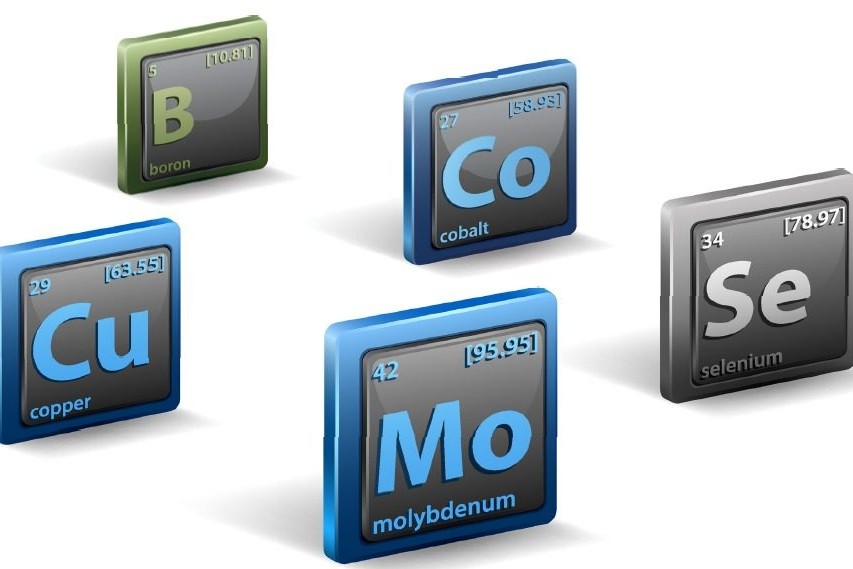The five essentials
Doug Edmeades discusses the issue of trace elements including the under use of Molybdenum.

Doug Edmeades discusses the issue of trace elements including the under use of Molybdenum.
The late Professor Walker told us that if he wanted to become a millionaire he would start out as a trace element salesman.
His reasoning was sound. You are dealing with small things that can have large effects and it is often a matter of life and death for the animals. Put together, the subject becomes emotional.
This makes an ideal environment for the muck and mystery man keen to score a few sales at the expense of gullible farmers. This is consistent with my own experience working with farmers. It is a subject that usually provokes lively discussion.
In our NZ context there are nine elements classified as trace elements – trace because they are present or only required at low concentrations. Of these there are five which are of particular concern.
Alphabetically: Boron (B), Cobalt (Co), Copper (Cu), Molybdenum (Mo), and Selenium (Se). Importantly, B is essential for plants, particularly brassicas, but not for animals and Co and Se are essential for animals but not for plants.
The other trace elements, Iodine (I), Iron (Fe), Manganese (Mn), and Zinc (Zn) are of minor concern.
Very good technical summaries in the public domain cover the critical levels for the trace elements required in soils, plants and animals and the amounts required to correct nutrient deficiencies (e.g. “Use of Trace Elements in NZ Pastoral Farming available free at fertiliser.org.nz/site/resources/booklet”).
This booklet also describes the role these trace elements play in the soil/pasture/animal system. There is no need to regurgitate this, but some points about the management of trace elements are worth emphasising.
The most frequent trace element problem we see is Mo deficiency. In our practice it occurs about 20% of the time. Going back to the pioneering days in the 1950s, it was found that tiny amounts of Mo applied to Mo-deficient soils resulted in spectacular improvement in clover growth.
Given these results – a huge increase in pasture production for such little expense – farmers ‘overdid it’ and ran into problems.
Too much Mo in the diet ‘locked’ up the Cu ingested by the animal inducing Cu deficiency – a horrible wasting disease, particularly in cattle. This resulted in a backlash, with farmers who then swore not to use Mo again and passed this experience on to the next generation.
The consequence over time is that they mined the soil Mo reserves ending up with Mo deficiency. Out of the frying pan and into the fire!
There was a time when trace element problems could be predicted by the soil group. For example, Se and Co deficiency (in animals) and Mo deficiency (in clover) were problems exclusive to sedimentary soils.
Mo deficiencies in Waikato
Cu problems occurred in peats and some pumice soils. These patterns of deficiencies may not necessarily hold. For example, we are discovering cases of Mo deficiency on ash soils in the Waikato. I think this is occurring because we have been farming these soils for 100 years and the once-adequate levels of Mo in these soils has been depleted.
At the practical level, trace element deficiencies manifest themselves in several ways on the farm: a) poor clover growth (Mo), b) poor growth in brassicas (B), or c) poor animal health (Co, Se or Cu).
Clover is very sensitive to Mo deficiency. The absence of clover in the pasture, or if clover growth is restricted to excreta, and other nutrient rich areas, is a visual clue of Mo deficiency.
There is no soil test of Mo so the only way to determine the soil Mo status is via analysing clover-only samples (leaves only). These should be collected by being very careful to avoid any nutrient-rich areas (dung and urine patches and camping areas). A handful of clover leaves is required for analysis.
The samples should be analysed choosing the ‘Clover profile’ which will also measure the macro nutrient concentrations, noting that the absence of clover can also occur if there are macronutrient deficiencies.
Boron deficiency is not known to occur in mixed pastures but should be applied to brassica crops and to clover grown for seed. B is required in the fruiting stages of plant growth.
If the concern is the trace element status of the grazing animal, tissue tests (blood and/or liver) should be taken from selected animals. This will require input from a vet.
To complement the results from the vet, mixed-pasture samples should be collected, to find out what the animal is eating in terms of the trace elements Co, Cu and Se i.e. a mixed-herbage sample, collected randomly, to grazing height.
These samples should be analysed using the ‘Animal Health Profile.’
I am often asked why we do not have soil tests for the trace elements? Unfortunately, and despite trying, we have not yet developed and calibrated soil tests for the trace elements.
Sure, it is possible to measure the concentrations of the various trace elements in the laboratory but the numbers in the lab do not necessarily relate to what the plant sees in the field. In other words what the plant ‘sees’ and what the labs ‘sees’ are not correlated. Some labs do offer full trace element analyses. The interpretation of such information should be treated very cautiously.
One final comment. The amounts of various trace elements ingested by an animal are the product of its concentration in the feed and the amount of feed ingested. For this reason some trace element deficiencies can be simply a consequence of underfeeding rather than an absolute soil deficiency.
- Dr Edmeades is a scientist and owner of agKnowledge, a science consultancy.




